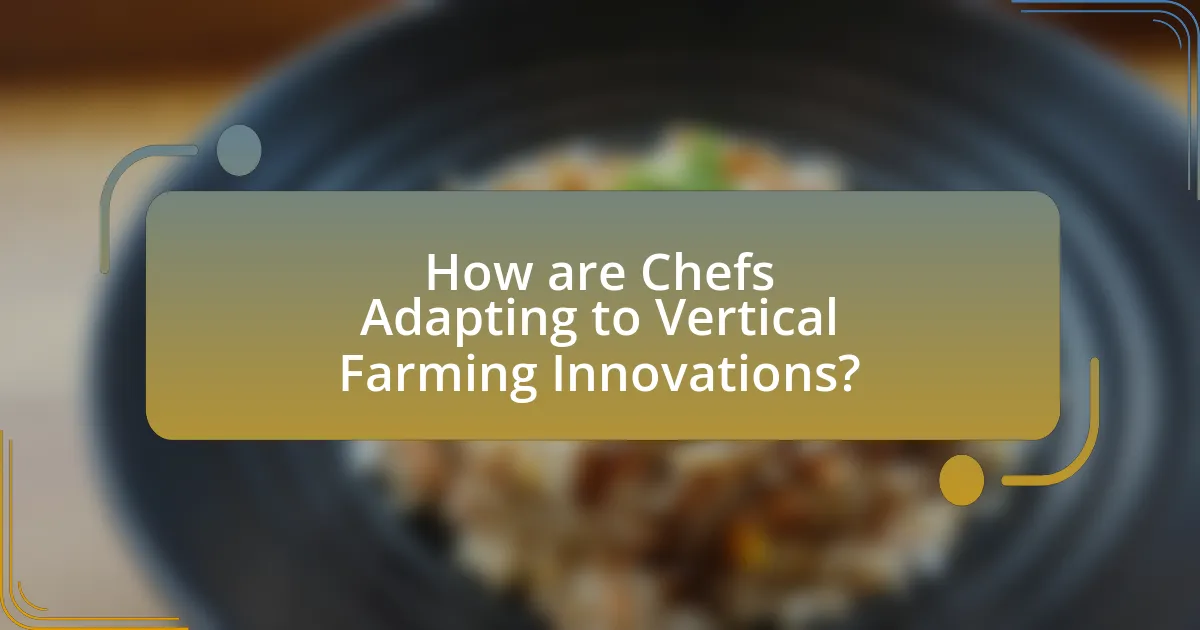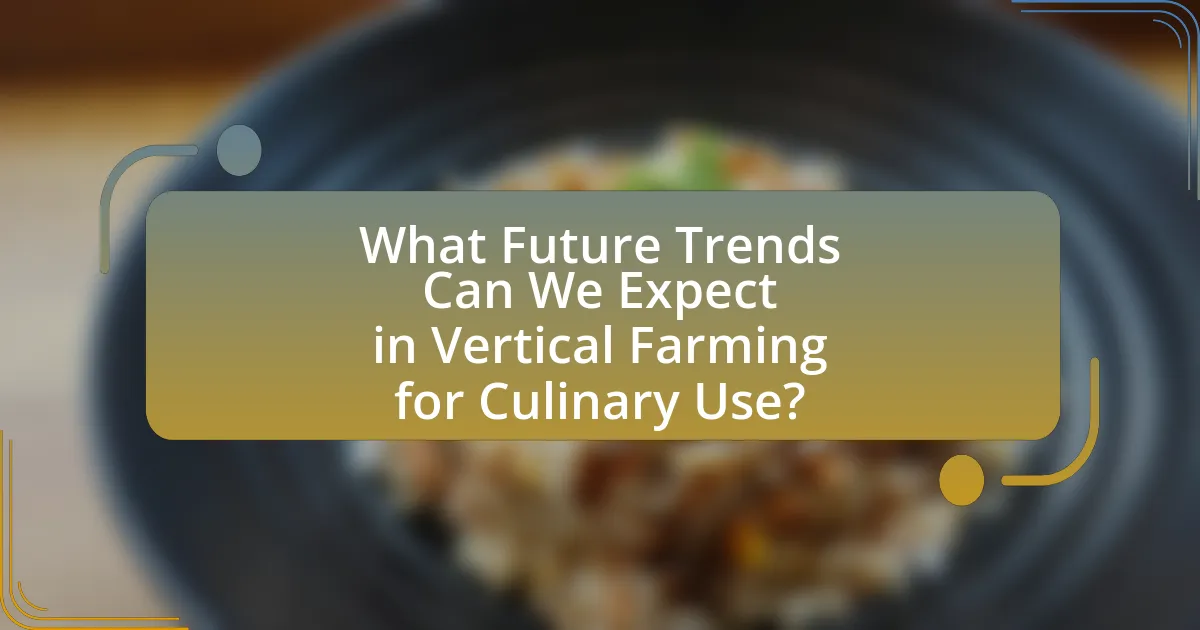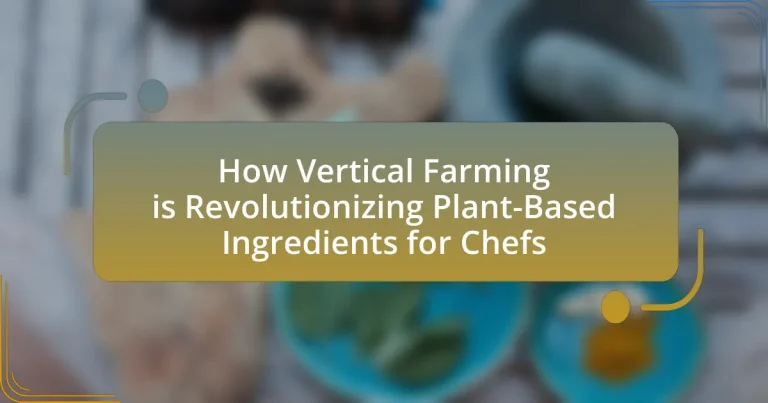Vertical farming is revolutionizing the culinary landscape by providing chefs with fresh, locally sourced plant-based ingredients year-round, independent of climate conditions. This innovative agricultural method utilizes controlled environments to maximize crop yields, reduce resource consumption, and enhance the nutritional quality of produce. Key principles of vertical farming include the use of stacked layers, hydroponics, and climate control systems, which collectively contribute to sustainable food production. The article explores the differences between vertical and traditional farming, the technologies involved, the significance for plant-based ingredients, and the challenges faced by chefs in integrating these practices into their culinary offerings. Additionally, it highlights future trends and the potential impact of vertical farming on global food security and urban agriculture initiatives.

How is Vertical Farming Transforming the Culinary Landscape?
Vertical farming is transforming the culinary landscape by providing chefs with fresh, locally sourced ingredients year-round, regardless of climate conditions. This innovative agricultural method utilizes controlled environments to grow a variety of crops in urban settings, significantly reducing transportation time and carbon footprint. For instance, vertical farms can produce leafy greens and herbs in as little as 30 days, compared to traditional farming methods that may take months. Additionally, studies show that vertical farming can yield up to 10 times more produce per square foot than conventional farming, enhancing ingredient availability for chefs and allowing for more diverse and sustainable menu options.
What are the fundamental principles of vertical farming?
The fundamental principles of vertical farming include the use of stacked layers to grow crops, controlled environment agriculture (CEA) techniques, and resource efficiency. Stacked layers maximize space utilization, allowing for higher crop yields per square foot compared to traditional farming. Controlled environment agriculture techniques, such as hydroponics, aeroponics, and climate control systems, enable precise management of light, temperature, humidity, and nutrients, resulting in optimal plant growth. Resource efficiency is achieved through reduced water usage, as vertical farms can use up to 90% less water than conventional farming methods, and minimized land requirements, making it possible to grow food in urban areas. These principles collectively contribute to sustainable food production and reduced environmental impact.
How does vertical farming differ from traditional farming methods?
Vertical farming differs from traditional farming methods primarily in its use of stacked layers and controlled environments to grow crops, allowing for year-round production regardless of external weather conditions. Traditional farming typically relies on large plots of land, natural sunlight, and seasonal cycles, which can limit crop yield and variety. Vertical farming utilizes hydroponics or aeroponics, reducing water usage by up to 90% compared to conventional agriculture, and can produce significantly higher yields per square foot, with some systems achieving up to 10 times the output of traditional farms.
What technologies are utilized in vertical farming systems?
Vertical farming systems utilize technologies such as hydroponics, aeroponics, and aquaponics to grow plants in controlled environments. Hydroponics involves growing plants in nutrient-rich water without soil, while aeroponics uses mist to deliver nutrients directly to plant roots. Aquaponics combines hydroponics with aquaculture, allowing fish waste to provide nutrients for plants. Additionally, vertical farming employs LED lighting for optimized growth, climate control systems for temperature and humidity regulation, and automation technologies for monitoring and managing plant health. These technologies enhance efficiency and yield, making vertical farming a sustainable solution for food production.
Why is vertical farming significant for plant-based ingredients?
Vertical farming is significant for plant-based ingredients because it enables the efficient production of high-quality crops in controlled environments, minimizing resource use and maximizing yield. This method allows for year-round cultivation, independent of climate conditions, which is crucial for meeting the growing demand for plant-based foods. Research indicates that vertical farms can produce up to 10 times more food per square foot compared to traditional farming methods, while using 90% less water. This efficiency not only supports sustainability but also enhances the availability of fresh, nutrient-dense ingredients for chefs, thereby revolutionizing the culinary landscape.
How does vertical farming enhance the quality of plant-based ingredients?
Vertical farming enhances the quality of plant-based ingredients by providing controlled environments that optimize growth conditions, leading to higher nutrient density and better flavor profiles. This method utilizes advanced technologies such as hydroponics and aeroponics, which allow for precise control over light, temperature, and humidity, resulting in faster growth cycles and reduced exposure to pests and diseases. Studies have shown that crops grown in vertical farms can have up to 30% more vitamins and minerals compared to those grown in traditional soil-based systems, thereby improving the overall nutritional value of the ingredients.
What environmental benefits does vertical farming provide for ingredient production?
Vertical farming provides significant environmental benefits for ingredient production by utilizing less land and water compared to traditional agriculture. This method can reduce water usage by up to 90% through recirculating systems, which minimizes waste and maximizes efficiency. Additionally, vertical farms often operate in urban areas, decreasing the need for transportation and thus lowering carbon emissions associated with food distribution. Furthermore, vertical farming can eliminate the use of pesticides and herbicides, leading to healthier produce and less chemical runoff into ecosystems. These practices contribute to sustainable food production, addressing issues of resource depletion and environmental degradation.
What challenges does vertical farming face in the culinary industry?
Vertical farming faces several challenges in the culinary industry, primarily related to scalability, cost, and product quality. Scalability issues arise because many vertical farms operate on a smaller scale, limiting their ability to meet the high demand of large culinary operations. Cost challenges stem from the significant initial investment required for technology and infrastructure, which can deter chefs and restaurants from adopting vertical farming practices. Additionally, product quality can be inconsistent, as the taste and texture of crops grown in controlled environments may not always match those grown in traditional soil, impacting chefs’ preferences for ingredient sourcing. These challenges hinder the widespread integration of vertical farming into culinary practices.
How can chefs overcome the limitations of vertical farming?
Chefs can overcome the limitations of vertical farming by integrating diverse sourcing strategies and utilizing advanced culinary techniques. By sourcing ingredients from multiple vertical farms, chefs can ensure a wider variety of produce, thus mitigating the limited crop selection often found in single vertical farming systems. Additionally, employing techniques such as fermentation, dehydration, and innovative flavor pairings can enhance the culinary potential of the crops available, allowing chefs to create unique dishes that maximize the use of vertically farmed ingredients. This approach not only addresses the limitations of crop diversity but also elevates the overall dining experience, showcasing the versatility of plant-based ingredients.
What are the economic implications of adopting vertical farming for chefs?
Adopting vertical farming has significant economic implications for chefs, primarily through reduced ingredient costs and enhanced supply chain efficiency. Vertical farming allows chefs to source fresh, locally grown produce year-round, minimizing transportation costs and spoilage associated with traditional farming methods. For instance, a study by the University of Arizona found that vertical farms can reduce water usage by up to 90% compared to conventional agriculture, leading to lower operational costs. Additionally, chefs can benefit from the ability to grow unique and specialty ingredients on-site, which can enhance menu offerings and attract customers willing to pay a premium for fresh, locally sourced food. This shift not only supports local economies but also aligns with growing consumer demand for sustainable and transparent food sourcing practices.

How are Chefs Adapting to Vertical Farming Innovations?
Chefs are adapting to vertical farming innovations by incorporating fresh, locally-sourced ingredients into their menus, which enhances flavor and sustainability. This adaptation is evident as many chefs are now sourcing herbs, greens, and vegetables directly from vertical farms, allowing for a farm-to-table experience that reduces transportation emissions and ensures peak freshness. For instance, a study by the Food and Agriculture Organization highlights that vertical farming can produce crops with higher nutrient density, which chefs leverage to create healthier dishes. Additionally, chefs are experimenting with unique varieties of plants that are often grown in vertical farms, thus expanding their culinary creativity and offering diners novel flavors and textures.
What types of plant-based ingredients are most commonly grown in vertical farms?
The most commonly grown plant-based ingredients in vertical farms include leafy greens, herbs, and microgreens. Leafy greens such as lettuce, spinach, and kale thrive in the controlled environments of vertical farms, allowing for year-round production. Herbs like basil, cilantro, and mint are also popular due to their high market demand and rapid growth cycles. Microgreens, which are young seedlings of vegetables and herbs, are cultivated for their intense flavors and nutritional benefits. These ingredients are favored in vertical farming because they require less space, have shorter growth periods, and can be produced with minimal water and pesticides, making them sustainable options for chefs.
How do these ingredients compare to those sourced from traditional farms?
Ingredients sourced from vertical farms typically exhibit higher nutritional density and lower pesticide residues compared to those from traditional farms. Vertical farming utilizes controlled environments that optimize growth conditions, resulting in produce that can have up to 30% more vitamins and minerals. Additionally, studies indicate that vertical farming can reduce pesticide use by up to 90%, leading to cleaner, safer ingredients. This method also allows for year-round production, ensuring consistent supply and freshness, which is often not achievable with traditional farming due to seasonal limitations.
What unique flavors and textures do vertical farmed ingredients offer?
Vertical farmed ingredients offer distinct flavors and textures that are often more vibrant and fresh compared to traditionally farmed produce. The controlled environment of vertical farms allows for optimal growing conditions, resulting in ingredients that can have enhanced sweetness, crispness, and aromatic qualities. For instance, herbs like basil and mint grown in vertical farms tend to have a more concentrated flavor profile due to reduced exposure to pests and diseases, which often leads to less stress on the plants. Additionally, the hydroponic systems used in vertical farming can produce leafy greens with a tender texture and a higher nutrient density, making them not only flavorful but also healthier options for chefs.
How are chefs incorporating vertical farming into their menus?
Chefs are incorporating vertical farming into their menus by utilizing fresh, locally grown produce that is cultivated in controlled environments. This method allows chefs to access a variety of herbs, greens, and vegetables year-round, enhancing the flavor and nutritional value of their dishes. For instance, restaurants are increasingly sourcing microgreens and specialty herbs from vertical farms, which can be harvested just before service, ensuring peak freshness. Studies indicate that vertical farming can produce up to 10 times more food per square foot compared to traditional farming, making it a sustainable choice for chefs aiming to reduce their carbon footprint while offering high-quality ingredients.
What are some successful examples of dishes featuring vertical farmed ingredients?
Successful examples of dishes featuring vertical farmed ingredients include salads, herb-infused oils, and gourmet pizzas. For instance, a restaurant in New York City utilizes vertical farmed microgreens to enhance the flavor and presentation of their signature salads, showcasing the freshness and nutritional benefits of these ingredients. Additionally, chefs are incorporating vertical farmed basil and other herbs into oils and sauces, which allows for vibrant flavors and sustainable sourcing. Gourmet pizzas topped with vertical farmed arugula and heirloom tomatoes demonstrate how these ingredients can elevate traditional dishes while promoting local and sustainable farming practices.
How can chefs promote the use of vertical farming in their culinary practices?
Chefs can promote the use of vertical farming in their culinary practices by incorporating locally sourced, vertically farmed ingredients into their menus. This approach not only highlights the freshness and quality of the produce but also educates diners about sustainable farming methods. For instance, chefs can showcase unique herbs and vegetables grown in vertical farms, emphasizing their flavor profiles and nutritional benefits. Research indicates that vertical farming can reduce water usage by up to 90% compared to traditional farming, making it an environmentally friendly choice. By actively engaging with local vertical farms and sharing their stories through social media and restaurant events, chefs can further raise awareness and encourage consumer support for this innovative agricultural practice.
What role does consumer demand play in the success of vertical farming?
Consumer demand is crucial for the success of vertical farming as it drives the market for locally sourced, fresh produce. Increased consumer interest in sustainability and health has led to a preference for fresh, pesticide-free vegetables, which vertical farms can provide year-round. According to a report by MarketsandMarkets, the vertical farming market is projected to reach $12.77 billion by 2026, largely fueled by consumer demand for fresh and organic produce. This demand influences vertical farming operations to optimize their production methods and crop selection, ensuring they meet the preferences of health-conscious consumers.
How are consumer preferences shifting towards plant-based diets?
Consumer preferences are shifting towards plant-based diets due to increasing health consciousness, environmental concerns, and ethical considerations regarding animal welfare. Research indicates that 39% of Americans are actively trying to incorporate more plant-based foods into their diets, reflecting a significant trend towards vegetarianism and veganism. Additionally, a report by the Plant Based Foods Association shows that plant-based food sales grew by 27% in 2020, highlighting a growing market demand. This shift is further supported by studies indicating that consumers perceive plant-based diets as healthier and more sustainable compared to traditional meat-based diets.
What impact does consumer education have on the acceptance of vertical farming?
Consumer education significantly enhances the acceptance of vertical farming by increasing awareness of its benefits and sustainability. Educated consumers are more likely to understand the environmental advantages, such as reduced land use and lower carbon footprints associated with vertical farming practices. Research indicates that informed consumers show a higher willingness to purchase products from vertical farms, as they recognize the freshness and nutritional value of locally grown produce. For instance, a study published in the journal “Sustainability” found that consumer knowledge about agricultural practices directly correlates with their purchasing decisions, demonstrating that education can lead to greater market acceptance of innovative farming methods like vertical farming.

What Future Trends Can We Expect in Vertical Farming for Culinary Use?
Future trends in vertical farming for culinary use include increased automation, enhanced crop variety, and integration of AI for optimized growth conditions. Automation technologies, such as robotics and sensors, will streamline planting, harvesting, and monitoring processes, improving efficiency and reducing labor costs. Enhanced crop variety will focus on growing specialty herbs and rare vegetables that are difficult to source, catering to chefs’ demand for unique ingredients. Additionally, AI integration will enable real-time data analysis to optimize light, water, and nutrient delivery, resulting in higher yields and better quality produce. These trends are supported by the growing market for vertical farming, projected to reach $12.77 billion by 2026, indicating a significant shift towards innovative agricultural practices in culinary applications.
How will advancements in technology shape the future of vertical farming?
Advancements in technology will significantly enhance the efficiency and sustainability of vertical farming. Innovations such as automated systems, artificial intelligence, and advanced hydroponics will optimize resource use, reduce labor costs, and increase crop yields. For instance, a study by the University of California, Davis, found that automation in vertical farms can lead to a 30% reduction in operational costs while improving production efficiency by up to 50%. Additionally, the integration of IoT devices allows for real-time monitoring of environmental conditions, enabling precise control over factors like light, temperature, and nutrient delivery, which can further boost plant growth and quality.
What innovations are on the horizon for vertical farming systems?
Innovations on the horizon for vertical farming systems include advancements in automation, artificial intelligence, and biotechnology. Automation technologies, such as robotics for planting and harvesting, are expected to enhance efficiency and reduce labor costs. Artificial intelligence will improve crop management through data analysis, optimizing growth conditions and resource usage. Additionally, biotechnology innovations, including genetically modified crops tailored for vertical farming environments, will increase yield and nutritional value. These developments are supported by research indicating that vertical farming can produce up to 10 times more food per square foot compared to traditional farming methods, making it a sustainable solution for urban agriculture.
How might these advancements affect ingredient availability for chefs?
Advancements in vertical farming significantly enhance ingredient availability for chefs by enabling year-round production of a diverse range of crops. This technology allows for the cultivation of fresh produce in urban areas, reducing reliance on seasonal and geographical limitations. For instance, vertical farms can produce herbs, greens, and vegetables in controlled environments, leading to a consistent supply regardless of external weather conditions. As a result, chefs can access high-quality, locally sourced ingredients more readily, which can improve menu creativity and sustainability.
What are the potential impacts of vertical farming on global food security?
Vertical farming has the potential to significantly enhance global food security by increasing food production efficiency and reducing reliance on traditional agricultural methods. This innovative approach allows for year-round crop cultivation in urban environments, minimizing transportation costs and spoilage, which can lead to fresher produce available to consumers. Studies indicate that vertical farms can yield up to 10 times more produce per square foot compared to conventional farming, addressing land scarcity and enabling food production in areas with limited arable land. Furthermore, vertical farming utilizes advanced technologies such as hydroponics and aeroponics, which can reduce water usage by up to 90% compared to traditional farming, thereby conserving vital resources. These factors collectively contribute to a more resilient food supply chain, capable of meeting the demands of a growing global population.
How can vertical farming contribute to sustainable food systems?
Vertical farming can significantly contribute to sustainable food systems by optimizing land use and reducing resource consumption. This method allows for the cultivation of crops in controlled environments, which can yield up to 10 times more produce per square foot compared to traditional farming. Additionally, vertical farms utilize up to 90% less water due to recirculation systems, minimizing water waste. Furthermore, they can be located in urban areas, reducing transportation emissions and ensuring fresher produce for local communities. Studies indicate that vertical farming can decrease the carbon footprint associated with food production, making it a viable solution for addressing food security and environmental challenges.
What role will vertical farming play in urban agriculture initiatives?
Vertical farming will play a crucial role in urban agriculture initiatives by enabling efficient food production in limited spaces. This method utilizes controlled environments to grow crops vertically, maximizing land use and reducing the need for pesticides and herbicides. According to a study by the National Academy of Sciences, vertical farms can produce up to 10 times more food per square foot compared to traditional farming methods, making them ideal for urban settings where land is scarce. Additionally, vertical farming can significantly reduce transportation costs and carbon emissions, as food can be grown closer to consumers, enhancing food security in urban areas.
What practical tips can chefs implement when using vertical farmed ingredients?
Chefs can enhance their culinary creations by incorporating vertical farmed ingredients through several practical tips. First, they should prioritize freshness by sourcing ingredients directly from local vertical farms, as these products often have a shorter time from farm to table, ensuring maximum flavor and nutritional value. Additionally, chefs can experiment with unique varieties of herbs and greens that are commonly grown in vertical farms, such as microgreens and specialty lettuces, to elevate their dishes.
Moreover, chefs should consider adjusting their cooking techniques to highlight the delicate textures and flavors of vertical farmed produce, such as using quick sautéing or raw preparations to preserve freshness. Lastly, they can engage with vertical farmers to understand the growing practices and flavor profiles of the ingredients, allowing for better menu development and seasonal adaptations. This approach not only supports local agriculture but also enhances the overall dining experience.


